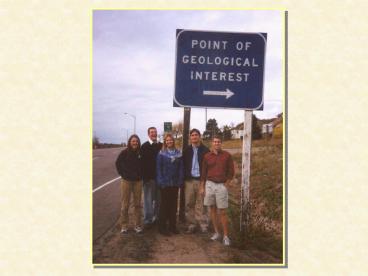The Nature and Status of Volcanoes - PowerPoint PPT Presentation
1 / 39
Title:
The Nature and Status of Volcanoes
Description:
VOLCANOES AND VOLCANISM. The Nature and Status of Volcanoes ... surface through fractures in the lithosphere. Occurs at plate boundaries and at hot spots. ... – PowerPoint PPT presentation
Number of Views:34
Avg rating:3.0/5.0
Title: The Nature and Status of Volcanoes
1
(No Transcript)
2
The Nature and Status of Volcanoes
ACTIVE - currently erupting volcano or one
that has erupted very recently.
Mt. Lassen, CA
Kilauea, HI
3
The Nature and Status of Volcanoes
DORMANT - has not erupted in the recent past,
up to 2000-3000 years, but has potential to
erupt.
Mt. Baker, WA
Mt. Shasta, California
4
The Nature and Status of Volcanoes
EXTINCT - has not erupted in very long
time, generally gt 10,000 years.
Heimaey, Iceland, prior to 1973, hadnt erupted
in 5000 years.
Shiprock, NM
5
CAUSES OF VOLCANISM
Generally caused by magma reaching the
Earths surface through fractures in the
lithosphere. Occurs at plate boundaries and at
hot spots. Influenced by Gas in volcanic
magma Magma viscosity
6
CAUSES OF VOLCANISM
GAS IN VOLCANIC MAGMA
1-9 of most magma is gas. Most common gases are
H2O and CO2. N, SO2 and Cl are also common. With
pressure, these gases remain dissolved. As magma
rises, pressure decreases. Gases separate. Rise
to top of magma body. Removal of pressure or
overlying rock causes dramatic release of
pressure. Leads to violent eruption.
7
So what?
8
CAUSES OF VOLCANISM
MAGMA VISCOSITY
Greater viscosity of magma, greater potential
for explosive eruption. Greater silica content,
greater viscosity. Mafic Magmas lower
viscosity rise to Earths surface gases
escape relatively easily erupt quietly with
gentle outpouring of lava
9
Intermediate Magmas higher viscosity tend
not to rise as readily gas movement is
impeded erupt explosively when they reach
Earths surface most common in terrestrial
volcanoes Felsic Magmas highest
viscosity behave similarly to intermediat
e magmas (often never erupt form
granite instead!)
10
PRODUCTS OF VOLCANISM
TYPES OF LAVA
BASALTIC LAVA Forms at high temperatures gt
1000C Has low viscosity, high
fluidity Produces two types of lava
11
1. PAHOEHOE Ropy lava Very low viscosity,
flows very fast Thin skin gets pushed up into
folds by the still moving lava below it.
12
PAHOEHOE
13
PAHOEHOE
14
PRODUCTS OF VOLCANISM
TYPES OF LAVA
BASALTIC LAVA
2. AA As lava cools and degasses, it becomes
more viscous. Gets a thick, brittle crust,
becomes more blocky. Surface breaks up as lava
flows underneath.
15
AA LAVA
16
PRODUCTS OF VOLCANISM
OTHER FEATURES OF BASALTIC LAVA
1. LAVA TUBES Tunnels along which lava once
flowed.
17
Craters of the Moon NP Will Junkin
18
PRODUCTS OF VOLCANISM
OTHER FEATURES OF BASALTIC LAVA
2. VESICLES Chambers produced as gas escapes
from lava.
19
PRODUCTS OF VOLCANISM
OTHER FEATURES OF BASALTIC LAVA
3. COLUMNAR JOINTING As lava cools, it
contracts. Contracts to form six-sided polygona
l columns.
20
(No Transcript)
21
COLUMNAR JOINTING 1. Devils Tower, WY 2.
Giants Causeway, Ireland 3. Devils Post Pile,
CA
1.
2.
3.
22
Giants Causeway Lea Korsmeyer
23
PRODUCTS OF VOLCANISM
OTHER FEATURES OF BASALTIC LAVA
4. PILLOW BASALTS Form when basaltic lavas flow
and cool underwater.
24
PILLOW BASALTS
25
PRODUCTS OF VOLCANISM
ANDESITIC LAVA
More viscous than mafic lavas. Doesnt flow far
from vent. Contains vesicles and aa
lava. Produces columnar jointing and pillow
structures.
RHYOLITIC LAVA
Flows extremely slowly. Erupts violently. Eruption
s produce airborne solid fragments. May produce
large amounts of pumice.
26
PRODUCTS OF VOLCANISM
PYROCLASTIC MATERIAL
Lava is expelled forcefully into the
atmosphere. Termed PYROCLASTIC. TEPHRA -
pyroclastic material that cools and
solidifies from lava as it flows through the
atmosphere. Produces distinct layers that can
be mapped and related to eruption events.
27
PRODUCTS OF VOLCANISM
TEPHRA
VOLCANIC DUST
Extremely fine tephra.
28
PRODUCTS OF VOLCANISM
TEPHRA
VOLCANIC ASH
Tephra with a grain-size lt2mm.
29
PRODUCTS OF VOLCANISM
TEPHRA
VOLCANIC CINDERS OR LAPILLI
Tephra with grain-size between 2 and
64 mm.
30
PRODUCTS OF VOLCANISM
TEPHRA
VOLCANIC BOMBS
Tephra with grain-size gt64mm.
31
PRODUCTS OF VOLCANISM
PYROCLASTIC FLOWS
Can have large amounts expelled by
volcanoes. Particles are generally large. Gravity
tends to pull the pyroclastic material
downhill. PYROCLASTIC FLOW or NUÉE
ARDENTE. Trapped air and magmatic gases keep
material suspended. Very low friction,
velocities gt150 km/hr (90 mi/hr).
32
PRODUCTS OF VOLCANISM
PYROCLASTIC FLOWS
NUÉE ARDENTE
Mt. Pelee, Martinique, 1908
33
(No Transcript)
34
PRODUCTS OF VOLCANISM
PYROCLASTIC FLOWS
Material in nuée ardente may not cool completely
before deposition. Soft material fuses with
other particles. Forms solidified tephra. Called
WELDED TUFF.
35
PRODUCTS OF VOLCANISM
VOLCANIC MUDFLOWS
Pyroclastic material mixes with water. Flows
downhill as a LAHAR. Generally happens where
abundant, loose, moist soil occurs. Tropical
regions provide this setting. Helps if volcano is
snow-capped or covered with glaciers. Ash and
dust may actually enhance the potential for
rain.
36
(No Transcript)
37
PRODUCTS OF VOLCANISM
LAHAR
Mt. Pinatubo, Philippines, 1991
38
Pillow Basalts
39
Active
Dormant































